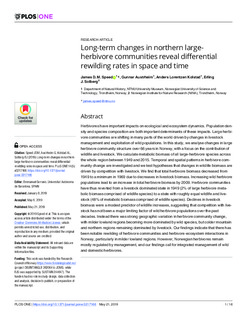| dc.contributor.author | Speed, James David Mervyn | |
| dc.contributor.author | Austrheim, Gunnar | |
| dc.contributor.author | Kolstad, Anders Lorentzen | |
| dc.contributor.author | Solberg, Erling Johan | |
| dc.date.accessioned | 2019-05-23T06:11:29Z | |
| dc.date.available | 2019-05-23T06:11:29Z | |
| dc.date.created | 2019-05-22T11:33:59Z | |
| dc.date.issued | 2019 | |
| dc.identifier.citation | PLoS One | nb_NO |
| dc.identifier.issn | 1932-6203 | |
| dc.identifier.uri | http://hdl.handle.net/11250/2598497 | |
| dc.description.abstract | Herbivores have important impacts on ecological and ecosystem dynamics. Population density and species composition are both important determinants of these impacts. Large herbivore communities are shifting in many parts of the world driven by changes in livestock management and exploitation of wild populations. In this study, we analyse changes in large herbivore community structure over 66 years in Norway, with a focus on the contribution of wildlife and livestock. We calculate metabolic biomass of all large-herbivore species across the whole region between 1949 and 2015. Temporal and spatial patterns in herbivore community change are investigated and we test hypotheses that changes in wildlife biomass are driven by competition with livestock. We find that total herbivore biomass decreased from 1949 to a minimum in 1969 due to decreases in livestock biomass. Increasing wild herbivore populations lead to an increase in total herbivore biomass by 2009. Herbivore communities have thus reverted from a livestock dominated state in 1949 (2% of large herbivore metabolic biomass comprised of wildlife species) to a state with roughly equal wildlife and livestock (48% of metabolic biomass comprised of wildlife species). Declines in livestock biomass were a modest predictor of wildlife increases, suggesting that competition with livestock has not been a major limiting factor of wild herbivore populations over the past decades. Instead there was strong geographic variation in herbivore community change, with milder lowland regions becoming more dominated by wild species, but colder mountain and northern regions remaining dominated by livestock. Our findings indicate that there has been notable rewilding of herbivore communities and herbivore-ecosystem interactions in Norway, particularly in milder lowland regions. However, Norwegian herbivores remain mostly regulated by management, and our findings call for integrated management of wild and domestic herbivores. | nb_NO |
| dc.language.iso | eng | nb_NO |
| dc.publisher | Public Library of Science (PLOS) | nb_NO |
| dc.rights | Navngivelse 4.0 Internasjonal | * |
| dc.rights.uri | http://creativecommons.org/licenses/by/4.0/deed.no | * |
| dc.title | Long-term changes in northern large-herbivore communities reveal differential rewilding rates in space and time | nb_NO |
| dc.type | Journal article | nb_NO |
| dc.type | Peer reviewed | nb_NO |
| dc.description.version | publishedVersion | nb_NO |
| dc.source.volume | 14 | nb_NO |
| dc.source.journal | PLoS ONE | nb_NO |
| dc.source.issue | 5 | nb_NO |
| dc.identifier.doi | https://doi.org/10.1371/journal.pone.0217166 | |
| dc.identifier.cristin | 1699444 | |
| dc.relation.project | Norges forskningsråd: 262064 | nb_NO |
| dc.description.localcode | © 2019 Speed et al. This is an open access article distributed under the terms of the Creative Commons Attribution License, which permits unrestricted use, distribution, and reproduction in any medium, provided the original author and source are credited. | nb_NO |
| cristin.unitcode | 194,31,10,0 | |
| cristin.unitname | Institutt for naturhistorie | |
| cristin.ispublished | true | |
| cristin.fulltext | original | |
| cristin.qualitycode | 1 | |

